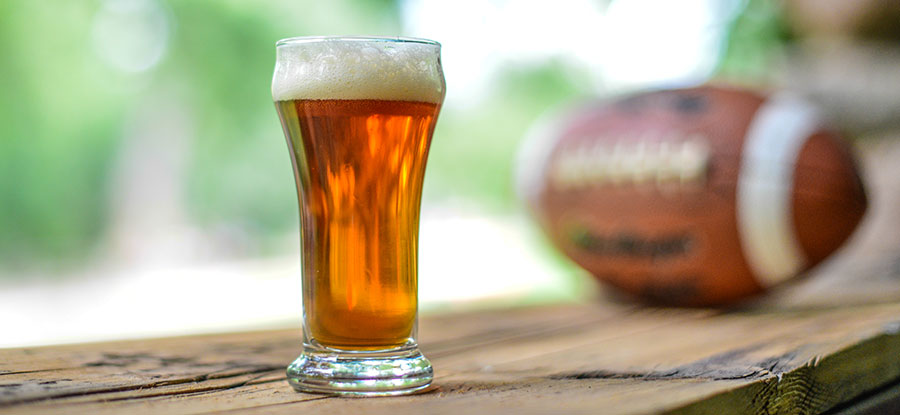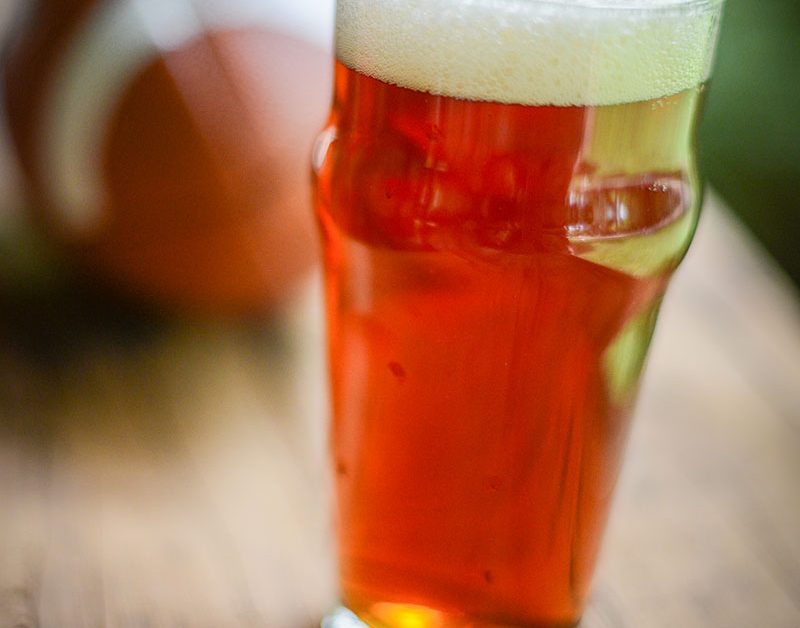As I sipped Left Hand Brewing Co’sOpens in new window Wake the Dead Russian Imperial Stout Nitro while watching the college football championship games unfold, I was eager to see which teams would make the second edition of the College Football Playoffs.
When the analysts began to pick apart the results of the day’s games and assess which teams they thought deserved a spot in the playoffs, and in which order, I couldn’t help but think how the top ten college football teams would measure up in a College Craft Beer Playoff.
College Craft Beer Playoff Ranking Criteria
In my quest to determine the College Craft Beer Playoff, I examined the top ten college football teams according to five beer-related areas:
- Number of craft breweries
- 2015 Great American Beer Festival medals
- Oldest craft brewery in town
- Closest brewery to campus
- Number of classes in brewing or fermentation sciences
The Break-Down
Just like the College Football Playoff Selection Committee, the criteria was part art and part science.
1. Number of craft breweries
For brewery count, I used the Brewers Association’sOpens in new window brewery locator and only counted breweries in the city itself. I didn’t dig further into micropolitan statistical areas (µSA) as the boundaries are always questionable. Some colleges were hurt by this.
For example, while Michigan State’s East Lansing metro area may boast six breweries (eight if you count Charlotte and Mason in the µSA), only one is located within the city limits of East Lansing. The same goes with Notre Dame and South Bend. Two breweries are located within the South Bend city limits with a potential of seven more depending on how far out the µSA is defined. This may sound unfair, so we’ll call this craft beer’s version of strength of schedule.
2. 2015 Great American Beer Festival medals
The medal count scoring is pretty cut-and-paste. A brewery either won a 2015 Great American Beer FestivalOpens in new window or not. Of the 29 breweries located across our top ten football schools, only one brewery has won a medal in 2015. Columbus, Ohio’s Elevator BrewingOpens in new window won bronze in the American-Style Wheat Beer category for Mogabi Wheat Ale.
I asked Dick Stevens, owner and elevator operator at Elevator Brewing why they were the only brewery to win a GABF medal amongst the top ten college football schools: “It’s your list,” Stevens said. “There are a lot of great breweries in college towns that don’t have a top football program this year. Terrapin in Athens, Georgia comes to mind. Also, a lot of the breweries are new. In the first two years of operation, most haven’t nailed brewing yet.”
He’s right. The lack of award winning beers has more to do with the newness of breweries located near college campuses. Of the eight schools in the college football top ten with breweries, only four have breweries older than four years old.
3. Oldest craft brewery in town
To qualify for points here, a brewery has to be operating today. I’m not interested in the oldest pre-Prohibition era brewery. Sorry, but a town still stuck in archaic Prohibition laws doesn’t deserve a bump in the rankings. A targeting call perhaps?
4. Closest brewery to campus
I used Google Maps to determine brewery proximity to the college. This, too, may hurt some schools as Google Maps defaulted to the admissions office. For some colleges, the office is in the center of campus; for others, it’s on the edge of the school property. Let’s call this a block in the back.
5. Number of classes in brewing or fermentation sciences
Lastly, I examined how many classes the university offers in brewing or fermentation sciences. At first, I looked at majors, but none of the top ten football schools offer a major in either topic. I was pleasantly surprised to find classes at four of the colleges, though, including Stanford, which lacks a single brewery in town.
Enough about the officiating. The game is played on the field. Or, in our case, the brewery.
Clemson Gets No Love
Much like in the sports columns of Monday morning quarterbacks, Clemson gets no love in our college craft beer discussion. In fact, the undefeated Tigers move from the number one spot in the College Football Rankings to dead last in the College Craft Beer Rankings.
Alas, when it comes to craft beer, Clemson neither has a single brewery in town nor do they offer any classes in brewing or fermentation sciences. This lack of a craft beer industry is not for a lack of want.
For the Clemson versus Notre Dame Game, the famed Esso Club collaborated with Brewery 85 to brew a craft lager for the game. The beer, called Esso Club Lager, has remained on the menu since. Esso Club Lager is one of the bar’s first attempts into what General Manager Candice Bell hopes is a growing selection.
“When it comes to craft beer bars in Clemson we have Nick’s, and I’d like to say us, but our craft program is so new,” says Bell. She cites a growing number of requests from students, locals, and visitors to carry more craft beer.
Robbie Hughes, store manager at Wall of Beer in Clemson, which offers 100 varieties of packaged craft beer and 20 taps for growlers fills, sees a similar growing interest in craft beer. “A lot of students come in for PBR and leave with a mix-six.”
Still, Clemson lacks its own craft brewery. The nearest brewery, Carolina Bauernhaus Ales, is 17 miles away in Anderson, South Carolina. Perhaps the lack of a craft brewery is the reason Clemson fans hang onto to their 1981 College Football Championship like it was yesterday.
The Final Four
Of the four College Football Playoff teams, one qualifies for the College Craft Beer Playoff—Michigan State. While the Spartans only have one brewery in East Lansing (that flag hurts, doesn’t it?), the brewery, Harpers Restaurant and Brewpub, is located a tenth of a mile from campus, earning MSU a first place spot under the distance category.
That brewery is also the third oldest brewery on this list, opening in 1997. Also, MSU ranks number one for most classes offered in brewing and fermentation sciences.
Alabama and Oklahoma fall right outside the Craft Beer Playoff at five and six. Both schools have relatively young craft beer scenes. Oklahoma’s only brewery, (405) Brewing, opened in 2015, and the oldest of Tuscaloosa’s two breweries, Druid City Brewing, opened in 2012.
Bo Hicks, co-owner, and brewer at Druid City Brewing, only expects craft brewing to increase in Tuscaloosa. The third brewery in town is slated to open any day now. Also, Hicks has hopes to work with the university to create classes on brewing and fermentation sciences.
“There is a lot of opportunity for a graduating student to land a job in craft beer if they know the science behind yeast,” said Hicks.
Until then, Druid City has fun with the proximity to campus. A chalkboard in the brewery is often covered with a mural poking fun at football opponents or heralding the success of the Crimson Tide.

If the College Football Playoff teams were to match up based on their craft beer scene, Florida State and North Carolina would occupy the three and four spots with a tie. Florida State lists four breweries in Tallahassee. The oldest, Proof Brewing, opened in 2007, demonstrating that FSU was an early adopter in the growth of craft beer. The closest brewery is a little over a tenth of a mile from campus, landing FSU in the number two spot for distance to campus.
While Chapel Hill only has two breweries, both are from the mid-90s, ranking the Tar Heels at number two for oldest brewery. Chapel Hill’s playoff spot was also boosted as Top of the Hill Brewing is the same distance from campus as FSU’s Grasslands Brewing. As mentioned above, Michigan State makes the playoffs and occupies the two seed, leaving the College Craft Beer Playoffs with only one spot to fill.
The Winner: Ohio State University
Unlike the 2002 National Championship Game, the Buckeyes didn’t need the boosters to call in a late flag in double overtime to secure the title. The Buckeyes demolished the college craft beer field with 16 craft breweries in town (not counting chains Gordon Biersch and Hofbrauhaus, or Budweiser’s local facility).
Within the strong pack of breweries, Columbus Brewing Co. is the oldest brewery of any town on the list dating back to 1988. Even if we considered pre-Prohibition breweries, OSU would likely still win. The original Columbus Brewing opened in 1830.
And, OSU is the only school on the list with the previously mentioned 2015 Great American Beer Festival medal. Finally, OSU helps keep the brewing industry in Columbus alive with two classes focused on brewing and craft beer.
The state itself has also helped the growth in craft breweries.
According to Stevens, “The liquor board encourages breweries to open.”
One way they’ve done that is by lowering the annual operating fee from $3,906 to $1,000 for craft breweries. “The lower cost helps a lot of younger people start up.”
As a proud graduate of Ohio University, it pains me to say this, but I heartily raise my mug to The Ohio State University for cultivating an amazing craft beer scene. Alas, I must admit that Columbus Brewing’s Pale Ale was my go to beer in college when my budget could afford it. Although, perhaps this glass should be filled with Elevator Brewing’s Bleeding Buckeye Red Ale.
College Foot Craft Beer Rankings
- Ohio State
- Michigan State
- North Carolina
- Florida State
- Oklahoma
- Alabama
- Iowa
- Notre Dame
- Stanford
- Clemson
CraftBeer.com is fully dedicated to small and independent U.S. breweries. We are published by the Brewers Association, the not-for-profit trade group dedicated to promoting and protecting America’s small and independent craft brewers. Stories and opinions shared on CraftBeer.com do not imply endorsement by or positions taken by the Brewers Association or its members.


Share Post